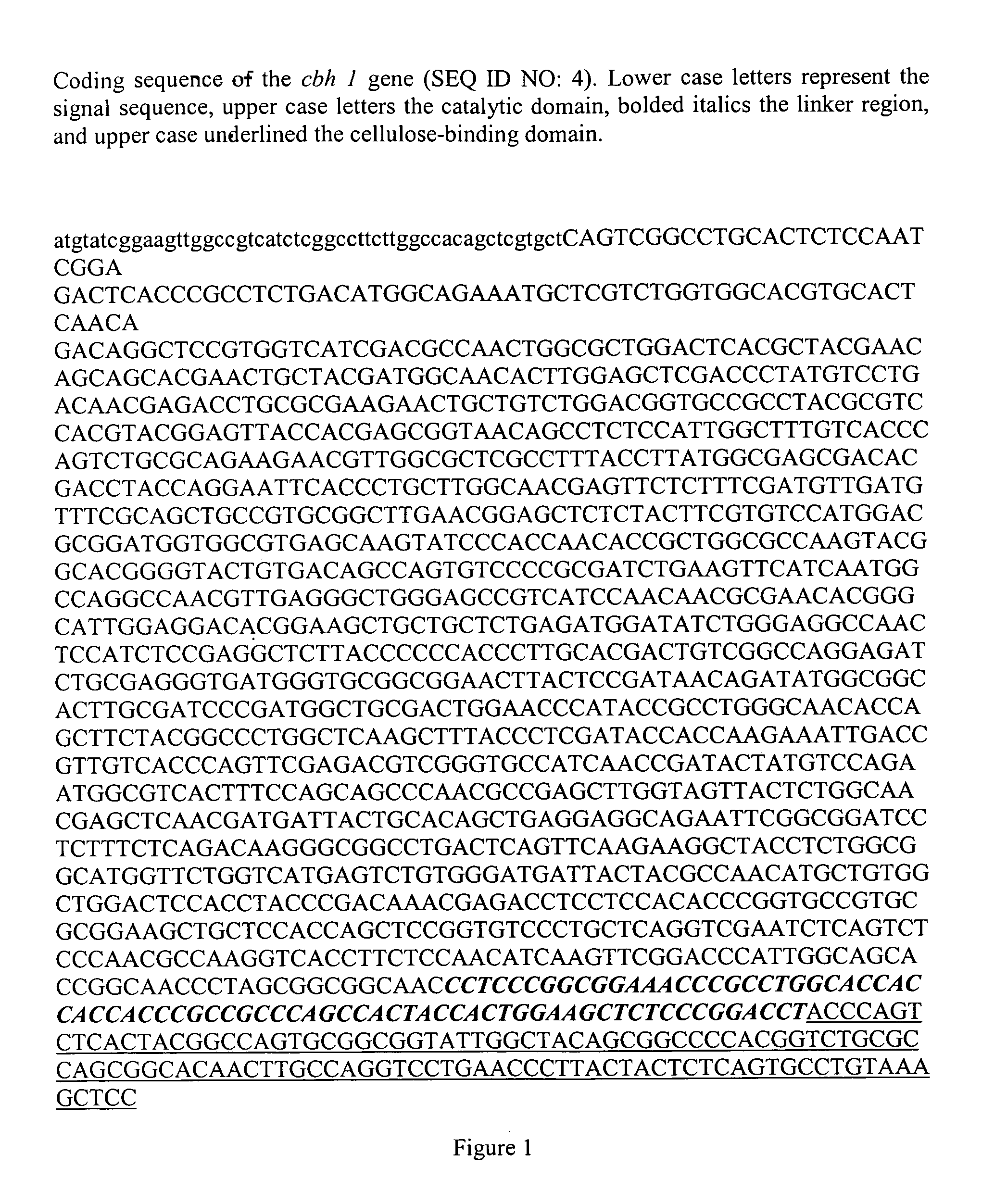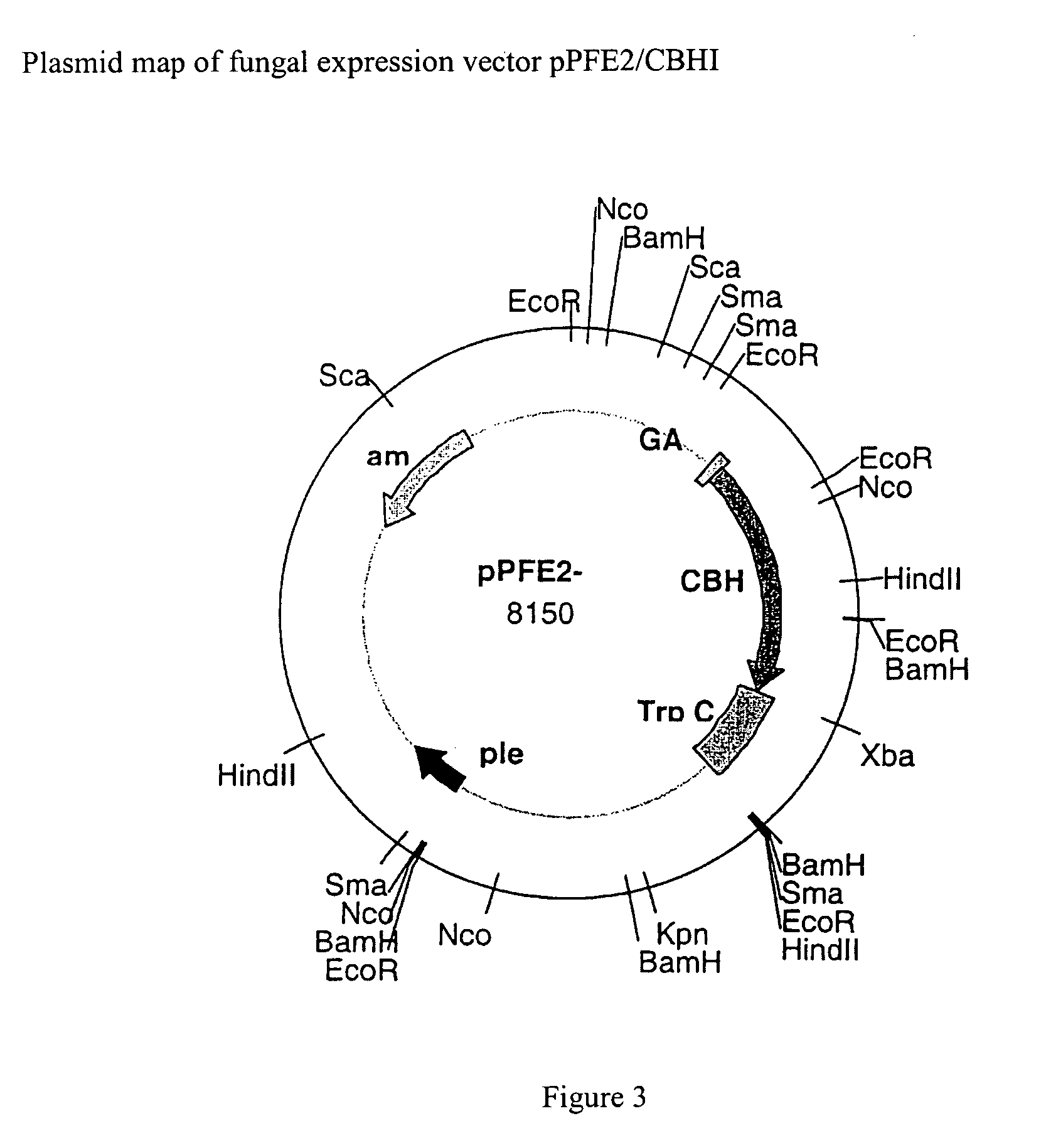Cellobiohydrolase I gene and improved variants
a cellobiohydrolase and gene technology, applied in the field of 1, 4cellobiohydrolases or exoglucanases, can solve problems such as impeded enzymatic activity, and achieve the effect of reducing the glycosylation of a cellobiohydrolase enzym
- Summary
- Abstract
- Description
- Claims
- Application Information
AI Technical Summary
Benefits of technology
Problems solved by technology
Method used
Image
Examples
example 1
Acquisition of the CBH I Encoding Sequence
[0022]Acquisition of the gene was done by either cDNA cloning or by PCR of the gene from genomic DNA. CBH I cDNA was isolated from a T. reesei strain RUT C-30 cDNA library constructed using a PCR-generated probe based on published CBH I gene sequences (Shoemaker, et al., 1983). The cDNA's were cloned (using the Zap Express cDNA kit from Stratagene; cat. #200403) into the XhoI and EcoRI site(s) of the supplied, pre-cut lambda arms. An XhoI site was added to the 3′ end of the cDNA during cDNA synthesis, and sticky-ended RE linkers were added to both ends. After XhoI digestion, one end has an XhoI overhang, and the other (5′ end) has an Eco RI overhang. The insert can be removed from this clone as an approximately 1.7 kb fragment using SalI or SpeI plus XhoI in a double digest. There are two Eco RI, one Barn HI, 3 SacI and one HindIII sites in the coding sequence of the cDNA itself. The plasmid corresponding to this clone was excised in vivo fr...
example 2
Production of Active Recombinant CBH I (rCBH I) in Aspergillus awamori. Construction of the Fungal Expression Vectors pPFE-1 / CBH I and pPFE-2 / CBH I
[0024]The coding sequence for T. reesei CBH I was successfully inserted and expressed in Aspergillus awamori using the fungal expression vector pPFE2 (and pPFE1). Vectors pPFE1 and pPFE2 are E. coli-Aspergillus shuttle vectors, and contain elements required for maintenance in both hosts. Both pPFE-1 and pPFE-2 vectors direct the expression of a fusion protein with a portion of the glucoamylase gene fused to the gene of interest. The pPFE1 vector contains a region of the glucoamylase gene, with expression under the control of the A. awamori glucoamylase promoter. The protein of interest is expressed as a fusion protein with the secretion signal peptide and 498 amino acids of the catalytic domain of the glucoamylase protein. The majority of the work presented here was done using the pPFE2 expression vector, which was chosen because of its s...
example 3
Method for Producing PCR Site Directed Mutations for Glycosylation Removal and Improved Thermalstability
[0036]The QuickChange™ Site Directed Mutagenesis kit (StrataGene, San Diego, Calif.) was used to generate mutants with targeted amino acid substitutions. To introduce these specific amino acid substitutions, mutagenic primers (between 25 and 45 bases in length) were designed to contain the desired mutation that would result in the targeted amino acid substitution. Pfu DNA polymerase was then used to amplify both strands of the double-stranded vector, which contained the CBH I insertion sequence, with the resultant inclusion of the desired mutation from the synthetic oligonucleotides. Following temperature cycling, the product was treated with the exonuclease Dpn I to digest the parental methylated DNA template and the PCR product was used to transform Epicurian Coli XL1-Blue supercompetent cells.
[0037]The vector pPFE2 / CBHI requires a relatively long PCR reaction (8.2 kB) to make s...
PUM
| Property | Measurement | Unit |
|---|---|---|
| temperature | aaaaa | aaaaa |
| concentration | aaaaa | aaaaa |
| pH | aaaaa | aaaaa |
Abstract
Description
Claims
Application Information
 Login to View More
Login to View More - R&D
- Intellectual Property
- Life Sciences
- Materials
- Tech Scout
- Unparalleled Data Quality
- Higher Quality Content
- 60% Fewer Hallucinations
Browse by: Latest US Patents, China's latest patents, Technical Efficacy Thesaurus, Application Domain, Technology Topic, Popular Technical Reports.
© 2025 PatSnap. All rights reserved.Legal|Privacy policy|Modern Slavery Act Transparency Statement|Sitemap|About US| Contact US: help@patsnap.com



